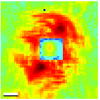issue contents
September 2013 issue

Cover illustration: Influence of Bragg diffraction on the phase shift of neutrons passing through a perfect silicon crystal. Depending on the crystal orientation, various Bragg conditions can be fulfilled resulting in an increase (red) or decrease (blue) of the ordinary refractive phase shift. [Lemmel (2013). Acta Cryst. A69, 459-474].
research papers
The theory and measurement of the neutron phase shift, index of refraction or coherent scattering length of perfect crystal samples in a neutron interferometer are described. Residual phase corrections far off-Bragg are identified as local field corrections.
Within the scope of the classical theoretical models, the diffuse scattering intensities (caused by the short-range atomic order) near the Bragg reflection in a (para)magnetic bulk face-centred cubic Ni3Fe-type permalloy are investigated, taking into account the long-range magnetic order and `strain-induced' effects. The analytic azimuthal and nonanalytic `radial' behaviours of the diffuse intensities as well as the `mixing' energy Fourier components are analysed in detail.
It is shown that the 15 minimal nets can serve as the labyrinth graph of one or other of the five known minimal surfaces of genus 3 and that the enumeration of such surfaces is likely to be complete.
Open  access
access
 access
accessA semi-transparent central stop has been used for ptychographic coherent diffractive imaging to increase the effective dynamic range in the recording of the far-field diffraction patterns. In this way, the high flux density provided by nano-focusing Kirkpatrick–Baez mirrors can be fully exploited for high resolution and quantitative phase reconstructions.
A model of the face-centred-cubic to body-centred-cubic martensitic transformation based on Pitsch distortion explains the continuum of martensite variant orientations observed in electron backscatter diffraction.
The cone of positive-definite quadratic forms is subdivided into subcones of combinatorial types of primitive parallelohedra in Ed, 2 ≤ d ≤ 6. An efficient algorithm is described.
A general class of iterative projection algorithms is proposed as a tool for phase determination in protein crystallography. The main iterative projection algorithms are described as well as their potential application to protein crystallography.
obituaries
Free 

book reviews
Free 



 journal menu
journal menu



























